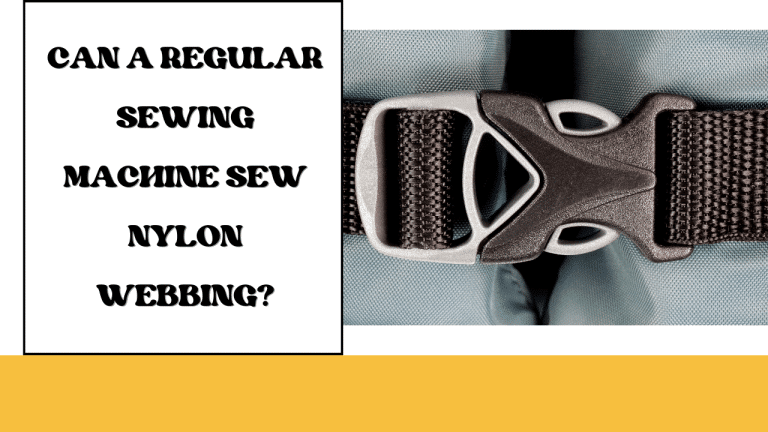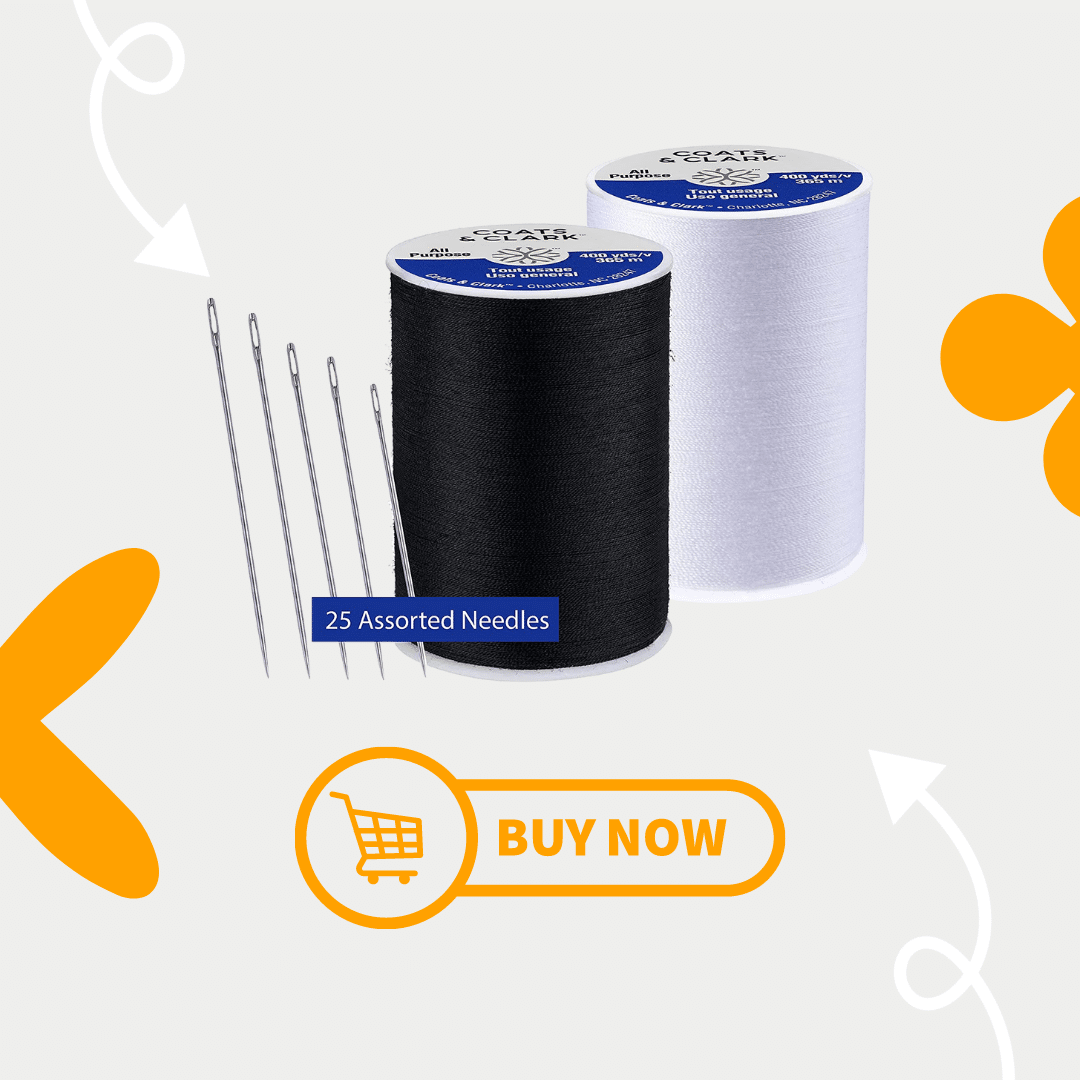Sewing nylon webbing can be a tricky process, as it requires a machine with a high-powered motor and industrial-grade needles to handle the tough fabric. Fortunately, with the right needle and thread, it is possible to use a regular home sewing machine to sew nylon webbing.
In this article, we’ll discuss the materials and techniques needed to sew nylon webbing with a regular sewing machine successfully.
Can a Regular Sewing Machine Sew Nylon Webbing?
Yes, a regular sewing machine can sew nylon webbing, but there are a few considerations to keep in mind:
Needle and Thread
When sewing nylon webbing, use a heavy-duty or denim needle. These needles have a stronger shaft and sharper point to penetrate the thick fabric more effectively. For thread, choose a strong option like nylon or polyester thread that can withstand the tension and weight of the material.
Tired of manually cutting threads? Discover sewing machines with automatic thread cutters in our comprehensive guide: What Sewing Machines Have Automatic Thread Cutter?. Say goodbye to hassle and hello to convenience!
Tension and Stitch Length
Adjusting the tension settings on your sewing machine is important when sewing thick fabrics like nylon webbing. Higher tension may be required to ensure that the stitches are secure and properly formed. Additionally, experiment with different stitch lengths to find the most suitable option for your project. A longer stitch length may be preferable for nylon webbing as it helps prevent unnecessary perforation and weakening of the fabric.
Test on Scrap Material
Before sewing on your final project, it’s advisable to test the stitching on a scrap piece of nylon webbing. This allows you to assess the tension, stitch length, and overall stitch quality before proceeding. It also helps you make any necessary adjustments to the machine settings.
Slow and Steady
Sewing through thick materials like nylon webbing requires a slower sewing pace to ensure that the needle penetrates the fabric properly and the stitches are securely formed. Rapid stitching may cause the needle to deflect or the thread to tangle. Maintain a steady pace to achieve clean and even stitching.
Considerations for Multiple Layers
If you need to sew multiple layers of nylon webbing together, it’s important to be aware of the limitations of your sewing machine. Some regular sewing machines may struggle to sew through thick layers. Adjust your machine’s settings accordingly, and if necessary, sew the layers in stages or seek assistance from a heavy-duty sewing machine or professional.
Optional Reinforcements
Depending on the intended use and load-bearing requirements of the sewn item, you may want to reinforce the stitching. This can be achieved by sewing additional rows of stitching parallel to the original seam or by backstitching at the beginning and end of the seam. Reinforcing the stitching adds extra strength and durability to the project.
Remember, the specifics may vary depending on your sewing machine model and the thickness of the nylon webbing. It’s always a good idea to consult your sewing machine’s manual for guidance and conduct some initial tests to ensure satisfactory results.
Common Mistakes to Avoid
Stitching Too Fast
One of the most common mistakes when sewing nylon webbing with a regular sewing machine is stitching too fast. While it may seem like a good idea to crank up the speed to get the job done quickly, it can cause the webbing to bunch up and warp.
This, in turn, can cause skipped stitches and uneven seams. To avoid this mistake, slow down your stitching speed and take your time.
Using the Wrong Needle
Another common mistake is using the wrong needle when sewing nylon webbing. A regular needle may work for lightweight fabrics but won’t hold up against heavy-duty materials like nylon webbing.
Using a small or medium needle will only lead to breakage or skipped stitches. It’s crucial to use a heavy-duty needle that can penetrate through the thick fabric layers of nylon webbing without breaking.
Inadequate Thread Tension
Inadequate thread tension is another frequent mistake that often results in poor stitch quality and weakened seams. If your thread tension is too loose, your stitch will look sloppy and have little holding power.
On the other hand, if your thread tension is too tight, it’ll snap easily under stress or leave unsightly holes in your fabric pieces. To avoid this mistake, test different thread tensions on scrap fabric before you begin sewing on your project.
Misuse of Seam Allowance
Misusing seam allowance happens more often than you might think when working with nylon webbing on a regular sewing machine. Sewing too close to the edge of the webbing causes fraying and weakens seams over time.
Sewing too far away from the edge makes it harder for you to sew two pieces of fabric together tightly enough without either slipping out of place or coming apart almost immediately after use. To avoid this mistake, measure and mark a seam allowance appropriate for the strength and size of your nylon webbing.
FAQs
Can I Sew Nylon Webbing with My Sewing Machine?
Yes, you can sew nylon webbing with your sewing machine. Use a heavy-duty or denim needle and strong thread, adjust the tension and stitch length, test on scrap material first, and sew slowly and steadily to ensure proper penetration and stitch formation. Consider the thickness and layers of the webbing to determine if your machine can handle it.
Can You Sew Webbing with a Regular Sewing Machine?
Yes, you can sew webbing with a regular sewing machine. Follow the same guidelines as mentioned before, using a heavy-duty or denim needle, strong thread, and making necessary adjustments to your machine’s settings. However, keep in mind that extremely heavy-duty tasks might require specialized machines designed for heavy materials.
What Kind of Sewing Machine Do I Need for Nylon Webbing?
For sewing nylon webbing, a regular sewing machine can suffice in most cases. However, if you frequently work with thick or heavy materials, you may consider a heavy-duty sewing machine. These machines are designed to handle thicker fabrics and provide greater stitching power and stability.
How Do You Attach Nylon Webbing?
To attach nylon webbing, position it where desired and use a straight stitch or zigzag stitch to sew along the edges or secure it in place. Reinforce the stitching with additional rows or backstitching if needed. It’s also possible to use webbing clips, buckles, or hardware to attach the webbing to other materials or objects.
What Kind of Thread Do You Use for Nylon Straps?
When sewing nylon straps, it’s best to use a strong and durable thread such as nylon or polyester thread. These threads have high tensile strength and can withstand the tension and stress that nylon straps may experience.
Is Nylon Webbing Easy to Sew?
Nylon webbing is generally considered easy to sew. It’s a durable material that can be sewn with a regular sewing machine using appropriate needles and thread. By following the recommended guidelines, adjusting machine settings, and practicing on scrap material, you can achieve satisfactory results. However, sewing thick or multiple layers of nylon webbing may pose challenges, so patience and proper techniques are important for success.

